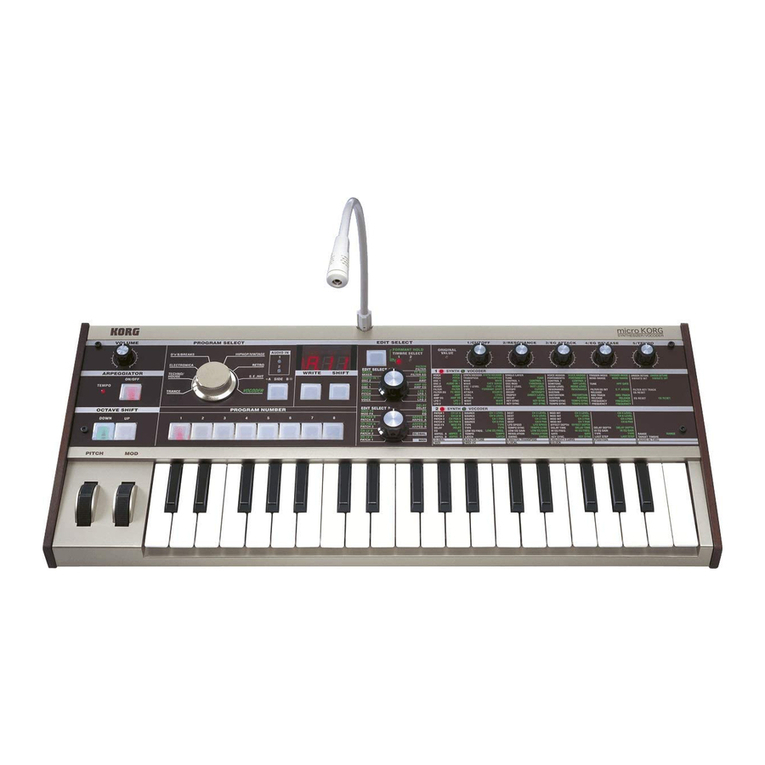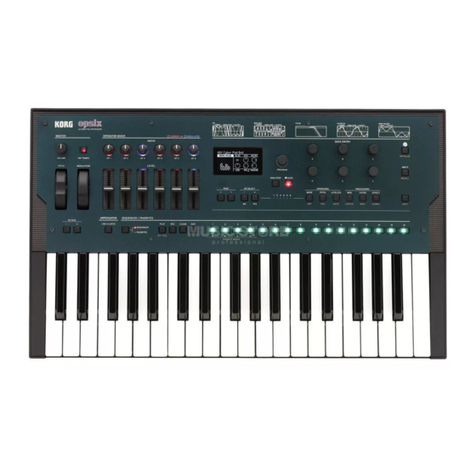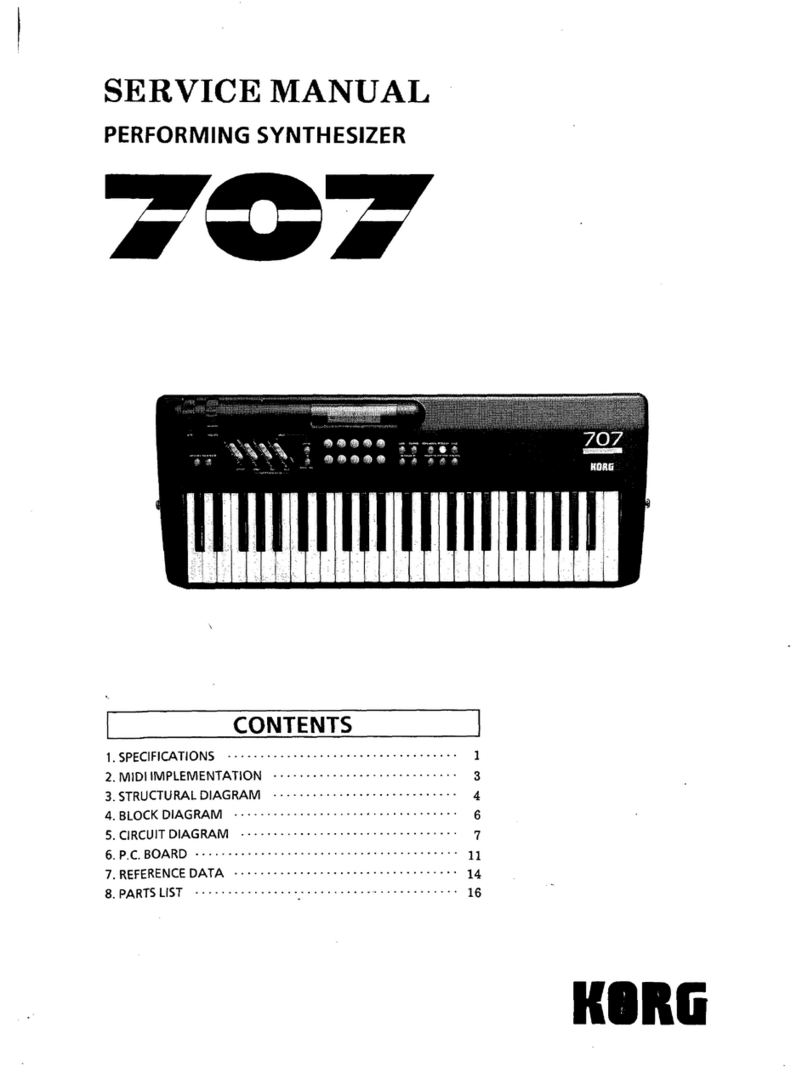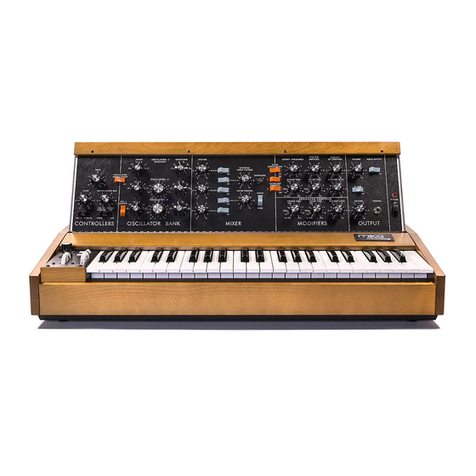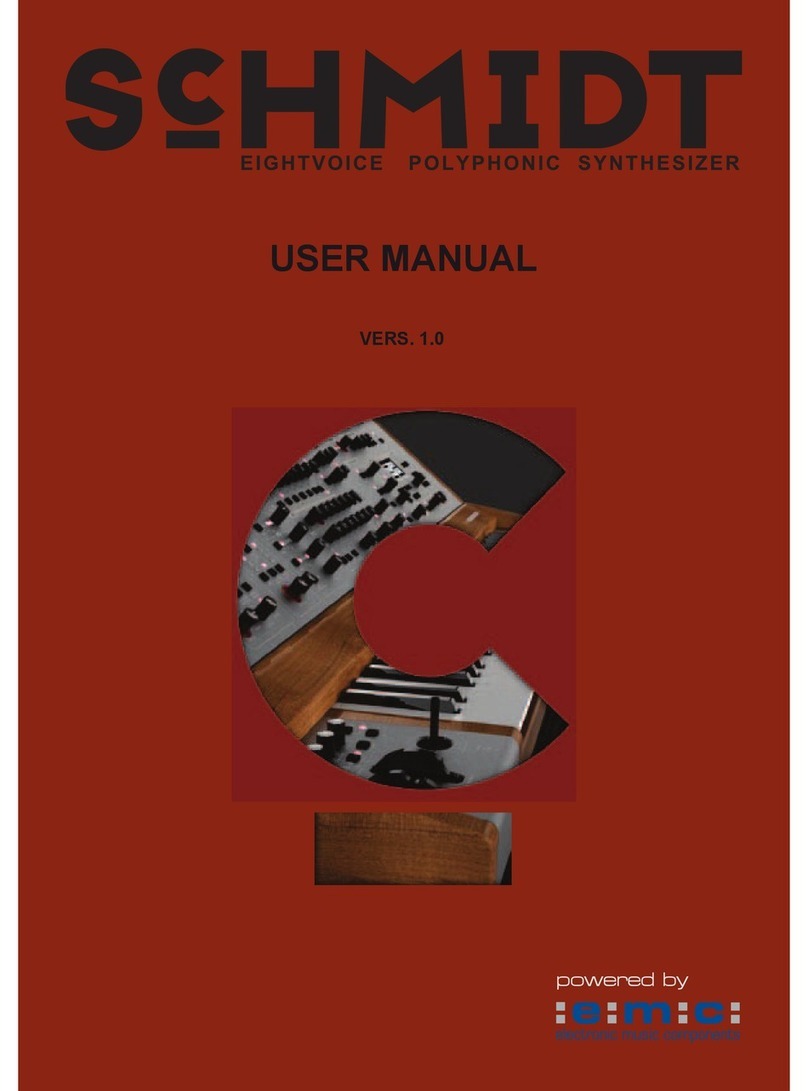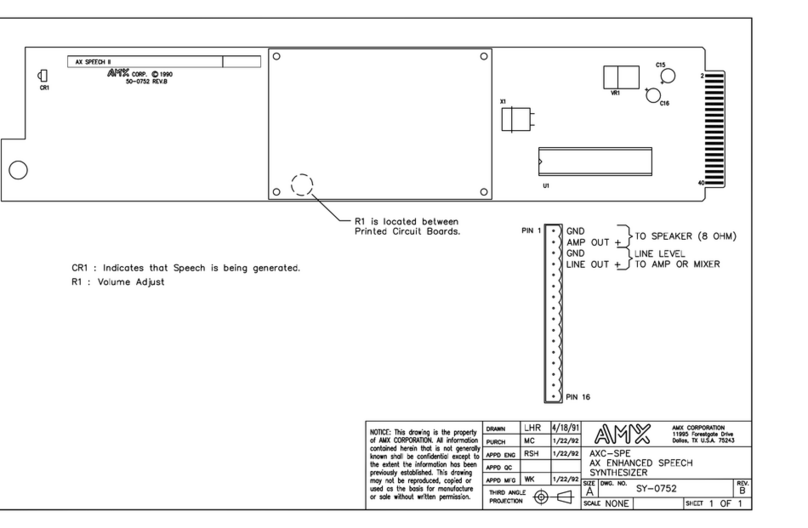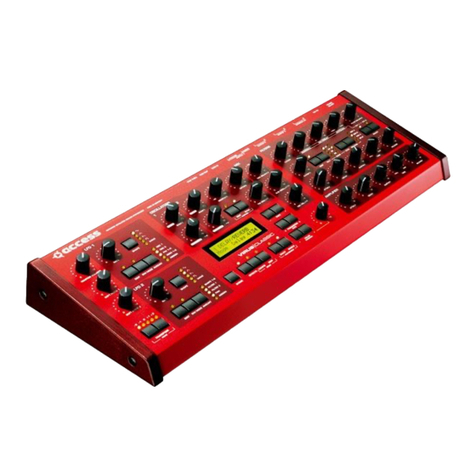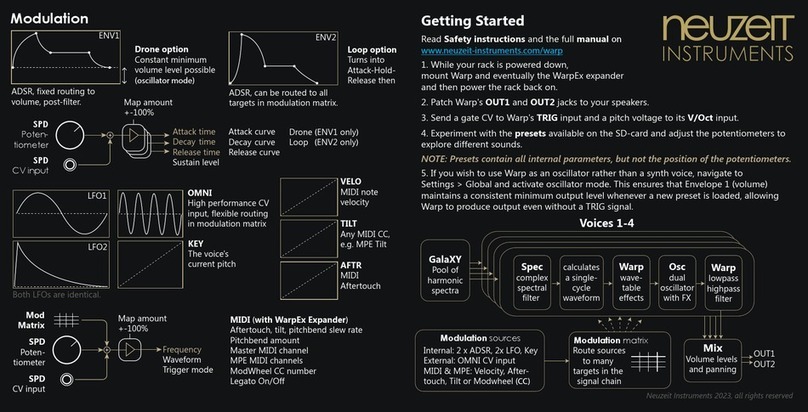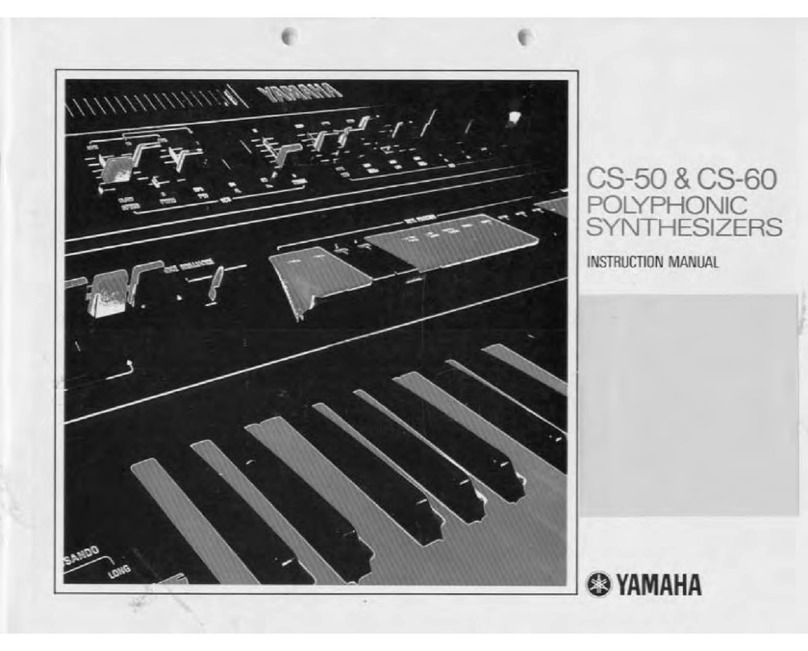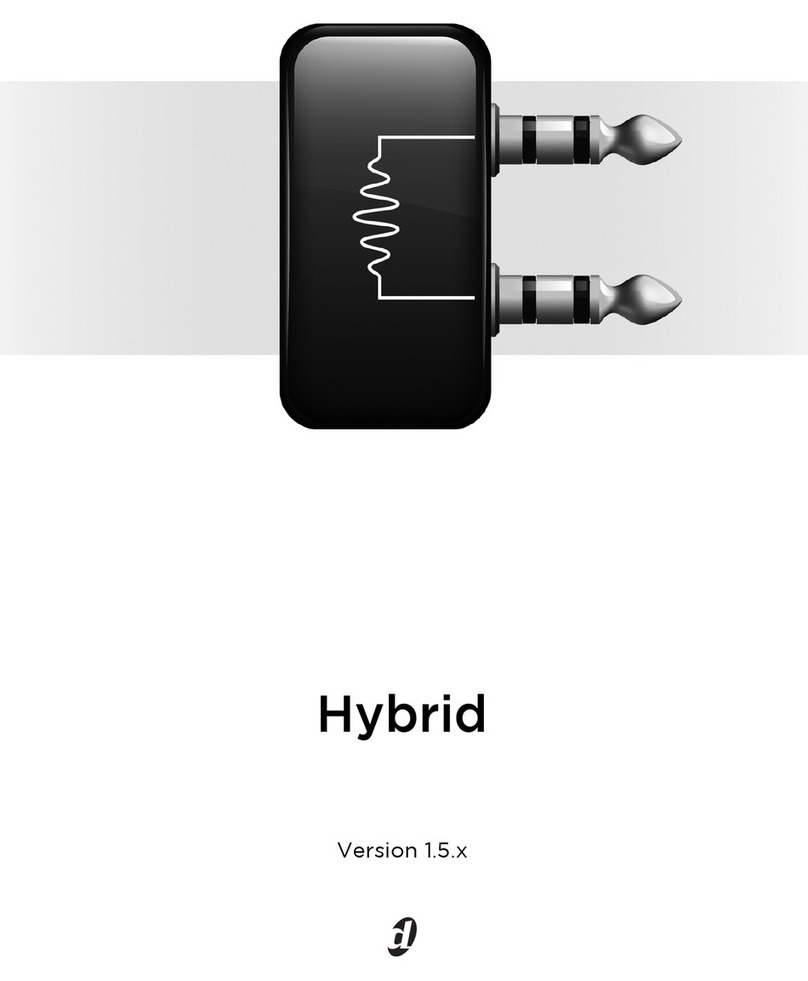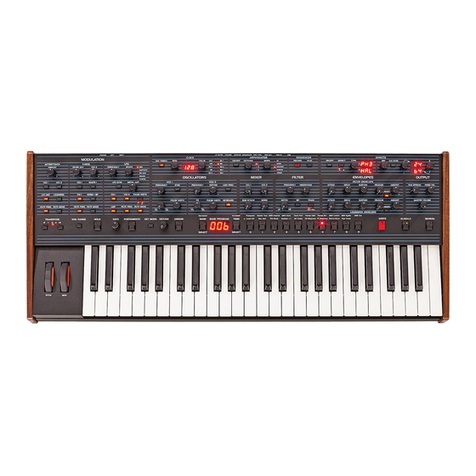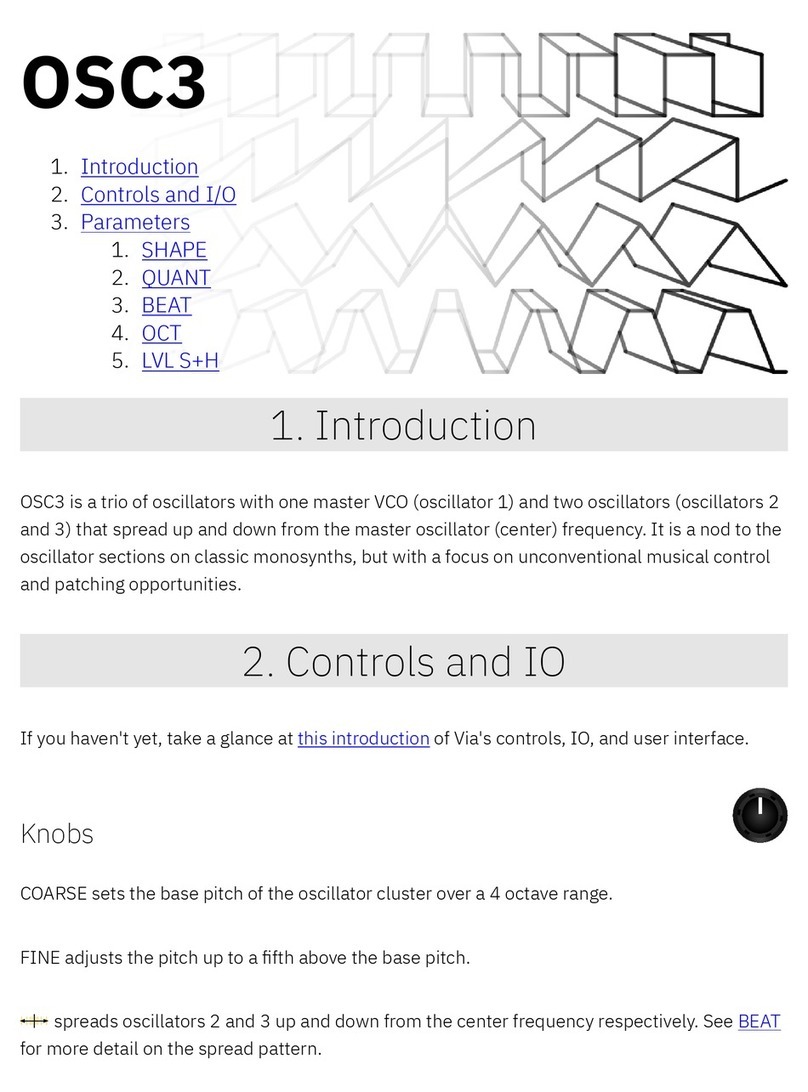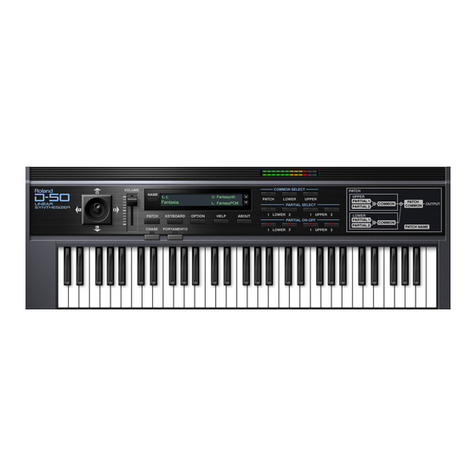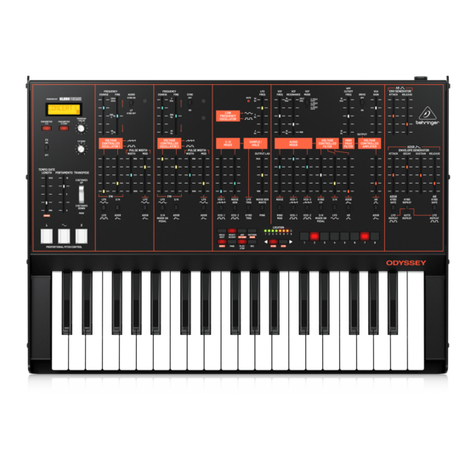Korg DSS-1 User manual

DIGITAL SAMPLING
SYNTHESIZER
OWNER’S MANUAL

Congratulations and thank you for choosing the K O R G D S S- 1
Digital Sam pling Synthesizer. Please read this m anual carefully to
obtain optim um performance and help assure long term
reliability.
BASIC PRECAUTIONS
■Place of use:
Avoid using this unit exposed to the following condi
tions.
• Direct sunlight
• High temperature and humidity
• Dust or sand
• Vibrations
Also, to assure proper floppy disk operation, use this
unit on a level surface,
■Power Supply
Use only with the rated A C voltage. If you need to use
this unit in areas having different power specifica
tions, please consult your KO RG dealer and use the
correct converter or transformer as necessary,
■ Interference with Electrical Applicances
This unit uses microprocessor circuitry that may
cause interference with nearby radio and TV
receivers. If problems occur, use at a greater
distance from the radio or TV.
■ Saving Data
Data in the D S S - r s memory includes program
parameter data and sound data that disappears when
the DSS-1 's power is turned off. Therefore, be sure to
save this data to floppy disk before turning off the
power.
■Handle Gently
Switches, knobs and other controls are designed to
operate with a normal touch. Excessive force will
lead to damage and malfunction,
■Transport
This unit uses a 3.5 inch floppy disk drive. To protect
the drive heads, remove any disc from the drive and
insert the head protection sheet before moving, ship
ping, or otherwise transporting this unit,
■Cleaning
To avoid harming the finish, use only a soft dry cloth
to wipe the exterior. Never use benzene or other
volatile cleaners or solvents. Never use polishes or
cleaning compounds,
■ Owner’s Manual
Keep this owner’s manual to refer to as you use this
equipment.
2

CONTENTS
~ FEATURES & FUNCTIONS 4
1. Front Panel 4
2. Rear Panel 6
3. Disk Drive & Floppy Disks 8
BEFORE PERFORMANCE 12
1. Basic Setup 12
2. Basic Operation 14
Basic 3. Performance Functions 19
section CREATING SOUNDS 23
1. Sound Synthesis Concepts 23
2. Making the Raw Materials (sounds) for a Multisound 27
3. Completing Your Multisounds 39
4. Using the Completed Multisounds 45
DATA MANAGEMENT 48
1. DSS-1 Memory, Data Structure, and System s 48
_ 2. Floppy Disks and Data Management 52
~ GENERAL OPERATION 55
1. Overview of the Operation modes 55
2. Example Applications of modes 60
SAMPLE MODE 61
1. Initial Operation 61
2, About Each of the Functions 63
CREATE WAVEFORM MODE 88
1. About Each of the Functions 88
EDIT SAMPLE MODE 102
1. About Each of the Functions 102
Operation MULTISOUND MODE 147
section 1. About Each of the Functions 147
PROGRAM PARAMETER MODE 196
1. About Each of the Functions 196
SYSTEM MODE 240
1. About Each of the Functions 240
DISK UTILITY MODE 270
1. About Each of the Functions 270
MIDI MODE 294
1. About Each of the Functions 294
2, DSS-1 MIDI IMPLEMENTATION 302
_ 3. Using the System Exclusive M essages 307
SPECIFICATIONS & OPTIONS 310
ERROR MESSAGES 311
About this Manual
This manual is divided into two main parts. The first part covers the basics, from
“B E FO R E P E R F O R M A N C E" through “DATA M AN AG EM EN T". The second part
covers operational details, from “G E N ER A L O PER AT IO N " to “MIDI M O D E ”.
We urge you to please read through the basic section. Then use the second part as
a reference manual, going to it when you need specific instructions for particular
operations.

FEATURES & FUNCTIONS
MASTER VOLUME
Volume control for syn
thesizer’s sound ouptut.
* MASTER TUNE
Used for tuning the DSS-1
to match the pitch of other
instruments. Pitch may be
adjusted over a range of
about + / - 5 0 cents.
■ DATA ENTRY A
■ DATA ENTRY B
These sliders are used to adjust the
values of parameters, to make selec
tions from menus, and other control
ant) entry purposes. After making rough
adjustment with the slider itself, use the
up/down arrow keys (ay) to make fine
adjustments.
* JOYSTICK
For real-time contol of pitch
bends, vibrato, filter modul-
tion, and other effects while
playing.
■ DELETE/CANCEL KEY
Used to cancel or delete
sampling operation, sample
names, program names and
so on. Also used to cancel
errors occuring during disk
access.
■ COMPARE KEY
Used only in the multi-sound
mode to restore the original
value after changing a value.
4

LCD
This liquid crystal
display shows data and
messages from the
DSS-1.
CONTRAST CONTROL
Turn this knob to adjust the LCD
for maximum legibility. If you
can not see anything on the
display, try turning this knob
clockwise.
-■ MODE SELECT KEY/FUNCTION MAP
Use the keys in this section to select the operating
mode. If a key's LED is illuminated then that mode
has been selected. If none of the mode key LEDs are
illuminated, then the DSS-1 is operating in the PLAY
mode. The functions available within each mode are
shown in the function list to the right of each of the
mode keys.
-m 10-KEY PAD
These ten keys, numbered
from 0 to 9, are used to
select program numbers, and
to select tunctions within
particular modes.
ENTER KEY
Used tc input data and to
begin disk access. Also used
tor “Key transpose" in the
play mode.
a CURSOR & YES/NO KEYS
Used to move the cursor (the short
underline that indicates your current
position) in the LCD readout and to
respond to messages from the
DSS-1.
5

AC CORD SOCKET
Connect the supplied
AC power cord to this
socket.
-■ POWER SWITCH
Turns DSS-1 power on
and off.
MIDI CONNECTORS
IN, OUT, THRO
For connection to other
MIDI equipment.
PROGRAM UP JACK
For connection of a loot
switch to advance the pro
gram (patch) number one
step at a time.
■ About the OUTPUT jacks.
* The audio output stage of the DSS-1 is equipped with
two digital delay lines, DDL-1 going to the LEFT out
put jack and DDL-2 going to the RIGHT jack. Depen
ding on the connection and the kind of output that
you want, the delays can be set for serial or parallel
operation as shown in the charts here.
if you use both jacks then you get parallel delay
which is recommended to provide the maximum
benefits of the dual delays for stereo chorus and
other stereo reproduction effects. However, if you
need monaural output, then you can connect to just
the RIGHT jack. This switches internally to a serial
connection from DDL-1 to DDL-2, combining their ef
fects. (If you use only the left jack, then you get the ef
fect of DDL-1 only.)
PAR ALLEL
— 1- DDL-1
DDL-2
OUTPUT
L
2 SERIAL
-----
D D H
7fr
OUTPUT
L
R
6

DAMPER JACK
For connection of a
foot switch to act like
a piano damper pedal.
PHONES JACK
Plug stereo head
phones in here.
OUTPUT
RIGHT JACK, LEFT JACK,
LOW/HIGH SWITCH
Audio output jacks and output level
switch.
AUDIO IN JACK
Input for audio signal (from
microphone, tape, etc.) to be
sampled.
★ The LOW/HIGH switch selects the output level for
both the LEFT and RIGHT output jacks. There is a
1:10 ratio between the LOW and HIGH position
voltages.
Output impedance does not change with switch
position. It remains fixed at 10 kohms whether you
select LOW or HIGH output level.
Switch Position
LOW HIGH
Maximum output
voltage About 0,8 V p-p About 8 V p-p
7

Ì.D is k Drive & Floppy Disks
1_ DISK DRIVE
8

■ Removing a floppy disk
■ Precautions when using the Disk Drive
★ Please save the head protection sheet that was in the
disk drive. Always remove any disk and put this sheet
in the drive before transporting the DSS-1 *
Store the protection sheet in a clean environment and
give it the same care that you would your floppy
disks. A dirty protection sheet will harm the drive and
damage any floppy disks used thereafter.
Head Protection
sheet
★ The busy indicator lamp comes on when the head is
moving over the disk surface to read or write data.
Never remove (eject) a disk or turn off the power
while the busy indicator is illuminated. To do so may
damage the disk and cause loss of valuable data that
is on the disk.
\ I *
s\ v
i
________
★ Always gently insert the disk straight into the slot.

2 FLOPPY DISKS
Top Bottom
(Label side)
■ Care of Floppy Disks
• Do not use or store your disks where they will be ex
posed to high temperature, high humility, direct
sunlight, dust or dirt.
* Do not open the shutter. To do so exposes the
magnetic disk to harmful dust, dirt, and scratches
which may prevent correct reading and writing of
data.
* Keep away from any source of magnetism including
TV sets, speakers, transformers, telephones, and
magnets. Magnetic fields will corrupt or erase your
data on the disk.
• Never transport the DSS-1 while a disk is in the drive.
The head will bounce against the disk, damaging the
magnetic disk surface and the head itself. This will
cause loss of your data and make the disk unusable.
• Never place anything on top of a floppy disk. The disk
may become deformed and unusable.
■ About the WRITE PROTECT HOLE
* The kind of floppy disk used in the DSS-1 has a "write
protect hole” which, when open, prevents you from
erasing or changing disk data.
Move the tab to open or close the hole as necessary
to prevent accidental data loss or to allow changes to
be made. Refer to the diagrams here. Be sure that
the tab is fully to one side or the other. (It gives a click
as it goes into place.)
■ Backup Copies
Regularly make backup copies of your disks and
store the copies separately. This is your only insu
rance against accidental erasure or corruption of your
valuable data. To make a copy, you get the data from
one disk, then write it to a different disk.
★ Write Disable position
4
Move the tab down so the
hole is open to prevent
writing of new data of
erasure of old data.
★ Write Enable position
\
— Move the tab up so that it
| closes the hote.
10

■ Which disks to buy
• The DSS-1 uses 3.5-inch double sided, double den
sity, double track micro-floppy disks. When you buy
more disks, check for a label that says: MF2DD,
DO U BLE SIDED, DO U BLE DENSITY, DO UBLE
TR A C K 135TPI. (TPI means tracks per inch.)
* Typical label of type of disks usable in the DSS-1
MF2DD
• D O U B L E SID ED
• D O U B L E D EN SIT Y
• D O U B L E TR ACK 135TPI
• The following disks are recommended:
KO RG MF-2DD, PAN ASO NIC EBF-MF2DD.
• Before using a newly purchased disk you must format
it by following the procedure called FO FORMAT DISK
while is detailed in a later section of this manual.
11

BEFORE PERFORMANCE
1 .Basic Setup
_____
■ Set up the DSS-1 as described below to enable play.
12
O

3; Turn down the volume all the way on the DSS-1
as well as on the connected amps, mixing con
soles, and other equipment. Then turn on the
power on the DSS-1 and other equipment.
r f e = r n
OFF | ON
I P O W E R 1
★ The display will appear as shown here. After
about seven seconds it will change as the
OSS-1 enters The SY ST E M MODE,
KmR G D '- '“ “ ! * * *
S A M P L I N G S Y N T H E S I Z E R
l
.
•i
* * * S Y S T E M M O D E * * *
s e l e c t - ( 1 - 9 ') s _
b
i
I
l
i
S\s, M
•On
13

O NE DISK
2
. Basic O p eratio n -
1 This lets you select sound patches from the disk
and play them.
■ The internal memory of the DSS-1 can hold up to 32
sound patch programs at once. During play, you se
lect from among these 32 sounds, changing from one
to another as you like.
Before play, you must load a set of 32 sound patch
programs from disk into memory. Each of these sets
is called a “system.”
■ One floppy disk can hold four “systems” of 32
sounds each. (That means that you can have 4 x 32
= 128 patches per disk.)
To load data from disk to internal memory, you must
choose which one of these four systems to load.
■ “G ET S Y S T E M ” is the name of the procedure that
you use to select and load one of these four systems
from a particular disk to internal memory.
“PRO G RA M S E LE C T ” is the name of the procedure
used to select and use one of the 32 sound patch pro
grams from the system that is currently in memory,
■ Therefore, to play a sound that is on disk, you first
choose the disk, then you choose a system and get it
(load it) from disk to internal memory. Finally you se
lect a program from among the 32 in the loaded sys
tem.
G ET SYSTEM : Lets you choose one ot the four systems on a disk
and load it to memory,
y
DSS-1 MEMORY: mt2] ®
\
PRO G R AM S E L E C T : Lets you select one of the 32 patches
(tone color programs) from memory.
2 Modes used for GET SYSTEM and PRO GRAM
SELECT
■ The G ET S Y ST EM procedure can be performed
when the DSS-1 is in the SY ST E M mode. When the
SY ST E M mode is selected, the SY ST E M key LED il
luminates.
(When the DSS-1 power is turned on, the SY ST EM
mode is selected automatically as the default mode.)
■ The P R O G R A M SE LE C T procedure is performed in
the PLAY mode. The DSS-1 is in the PLAY mode
when none of the mode selector key LEDs are on.
To switch to the play mode, press the mode selector
key which is currently selected, so that its LED goes
out. (The play mode is selected when the eight
modes listed on the front panel are all cancelled.)
• When SYSTEM mode Is selected.
SYSTEM
» it
LFD Is on
• When play mode is selected.
SAM PLE S V S T ftt
m
r -
EDIT SAMPLE DISK U TILITY
m
CRE ATE WAVEFORM PROGRAM PARAM ETER
F ~ 3
MULTI 5 0U N D
□All mode selector key
MIDI LEDs are off.
141

3 Get System & Program Select Procedures
■ Let's now try getting a system of the supplied disk
and then selecting a program to use tor playing the
keyboard. First prepare to begin as described in the
Basic Setup section. Then follow the steps below.
Operation
j) Insert the disk in the drive.
X Confirm that the SY ST E M mode is selected*
Check to see that the S Y ST EM mode key LED
is illuminated.
• When in the SY ST E M Mode.
SY STEM
K if
. . . —L E D js o n
Operation of DSS-1
X To select the G ET S Y ST EM function, press the
number 1 key on the 10-key pad.
Press
1The display confirms the G ET S Y ST E M function and
asks you to select from one of the four systems on the
disk*
Indicates GET SYSTEM function.
i
E N TE R
\ hr
Flashing -Prompts you to select a system.
15

^ There are lour systems per disk. These are
named A, B, C, and D.Use the DATA ENTRY A
to select one of these systems.
data entry a
t=
4
à
Use to select
System
T
% After selecting a system press the EN TER key.
Press to input selection.
Press to input
EN TE R
_L _ l _
Currently selected system.
a
• You are now asked to confirm your selection.
m . 4 1*1 1 H I H
I *1 ■ ■ i
r J. 'n il. \
■ I I » va »
!“» * ■”
■ * I HI 5. t
I U W
System that you chose.
__________________________
K -mpì i f» I R s t
ï ; * ; r Mur-i
r * f l I i W * m p * 4
P
K* f i‘* L J Ì-, j ’*■
wj L-u : \ ï >■ Fi
— i
Prompt,
6 Press the Y E S key to confirm your choice.
Press • This makes the DSS-1 proceed to load your selected
system from the disk to the internal memory. This
takes a while to complete.
F i 1 .-J ■r i"l
! z:1 r s
n '!
rw \ i4M
» j. ._ ... _. i s... * j. k .*.: , . ..i. .
U -d P * J .M u U ~ :
\
After loading, it confirms completion
Shows the name of loaded system.
rS
Pi SYS:ft U onp le ied
► I V I Ada *
‘- ü i p i i T . i. — 1™I 'ì Ü
.J-.H J- '<•* *-l-" . u -• .* 11
10

7; To allow selection of a particular patch or “pro
gram1', you need to go to the PLAY mode.
This requires pressing the SY ST EM key to
cancel the S Y ST EM mode and extinguish its
LED.
Press
LED is on.
• Cancels SY ST E M mode and switches DSS-1 to
PLA Y mode.
When SYSTEM mode is cancelled.
SY STEM
I ^ U eP is OFF.
Display for PLAY mode:
;@) There are several ways to select a program. You
can use the up/down arrow keys (marked with
triangles) by the DATA EN T RY A or B sliders. Or
you can use the 10-key pad to enter a two digit
number between 01 and 32 (inclusive).
Use these up/
down arrow keys.
E
i
or
T
Or use the ten
number keys (0—9).
7 a 9
*5 6
1 2 3
Use to select
Program
The loaded system (A, B, CP or D)
The selected program number.
The selected program name
7 To get a program from a different system, press
the SY ST EM mode key to return to the
SY ST E M mode. Then proceed from step X
above.
If the sound you want is on a different disk, first g o '
back to the S Y ST EM mode, eject the current disk,
. and insert the desired disk.

■ When using the ten number Keys (10-Key pad) to
select a program, be sure to always enter the number
as two digits. That is, program numbers one through
nine must be specified as 01, 02, 03, and so on.
• Example: To select program number three.
Press Then press
a
If you input an “illegal*1 number such as 00 or 34,
then the DSS-1 ignores the second digit and keeps
waiting until you enter a second digit that is a valid
program number. In this case you can return to the
previously selected program number by pressing the
DELETE/CANCEL key.
• Example: If you try to select number 34.
The second digit is ignored and the
DSS-1 keeps waiting for valid input.
The previously selected
program name remains
in the readout.
j
t
DEL/CANCEL
You can stili press
To return to the previously selected program number
i
■ It takes about half a second after selecting a program
until that patch can actually be played.

. Performance Functions
[T! Joystick
■ For control of pitch bends, vibrato, filter modulation
{wah-wah), and other effects while playing.
■ Left-right movement (horizontal axis) can produce up
ward and downward pitch bends (of all notes played)
and can control the VCF cutoff frequency to change
the tone color. Upward movement produces vibrato,
by modulating the oscillator frequency. Downward
movement produces a cyclic wah-wah effect by
modulation of the VCF filter cutoff frequency.
o s c
BEND BEND
VCF
■ The operation of these effects depends in part on the
program being used. Some parameters in a patch will
affect these functions,
2\
Initial Touch
■ The DSS-1 has programmable initial touch. This lets
you control things like volume, tone color, pitch
change, and attack, according to how fast or "hard"
you play the keys.
■ The effect produced depends on your patch
parameter values.
Ts] After Touch
■ The DSS-1 has programmable after touch. This is ac
cessed by pressing down on keys after playing them.
After touch can be programmed to control vibrato
depth, volume, brightness, and other aspects of the
sound.
■ The effect produced depends on your patch
parameter values.

[4] Key Transpose
■ This lets you shift the whole keyboard pitch up or
down in semitone steps, a valuable feature for play
ing music intended for other instruments or for
avoiding difficult keys* You can transpose upward by
up to 5 semitoines and downward by up to 6 semi
tones.
■ Key transpose is set in the play mode, using the enter
key and keys on the keyboard in relation to C. Press
any key up to F above C or F# below C. (Any C will
do.) You transpose up by pressing any key from C #
to F, giving you a range of +1 to + 5 semitones. You
transpose down by pressing any key from B to F#,
giving you a range of - 1 to - 6 semitones. The C key
itself cancels the transpose effect (since it transposes
by 0).
The current value of the transpose parameter is
shown on the display as a tone name from F# to F.
• Example: Transposing up 2 semitones.
When you play a D chord You hear an
E chord
Cancel
transpose
r - ©F
Transpose Transpose
down up
Procedure for using transpose:
Operation
Confirm that the unit is in the play mode.
: 2} Press the enter key.
ENTER
Press ]
Operation of DSS-1
Current transpose value is displayed and you are
prompted to press a key together with the enter key.
(Here the transpose value is C,)
KEV TRANSPOSE:C
p J1 1 f\ r**™'“4 L11
I 4 » w tala m f ■ * wm • ■ w ■f i.* ENT
20
Other manuals for DSS-1
5
Table of contents
Other Korg Synthesizer manuals
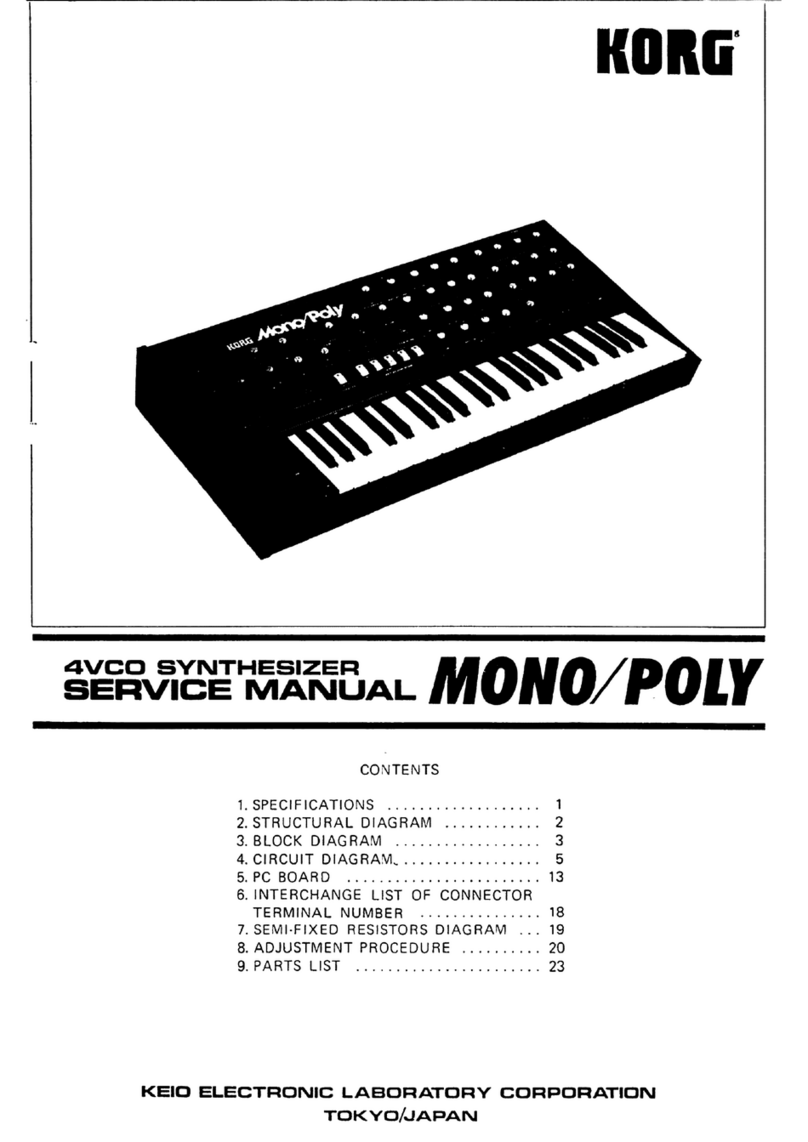
Korg
Korg Mono/Poly User manual
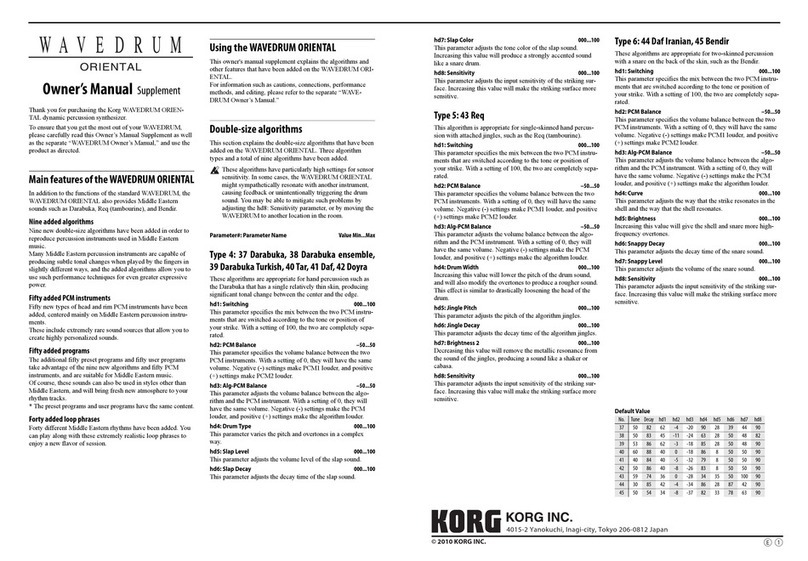
Korg
Korg WAVEDRUM ORIENTAL User manual

Korg
Korg Elec Tribe EA-1 User manual

Korg
Korg M-500 User manual
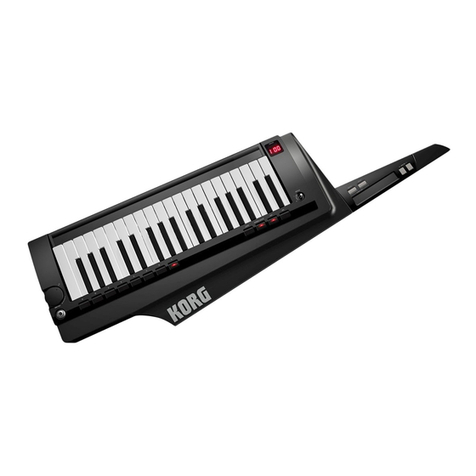
Korg
Korg RK-100S User manual
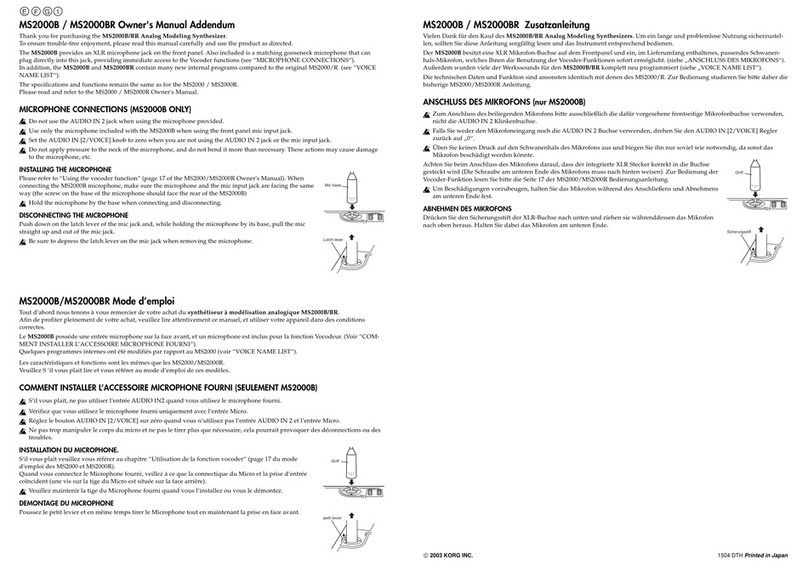
Korg
Korg MS2000BR Installation and operating instructions
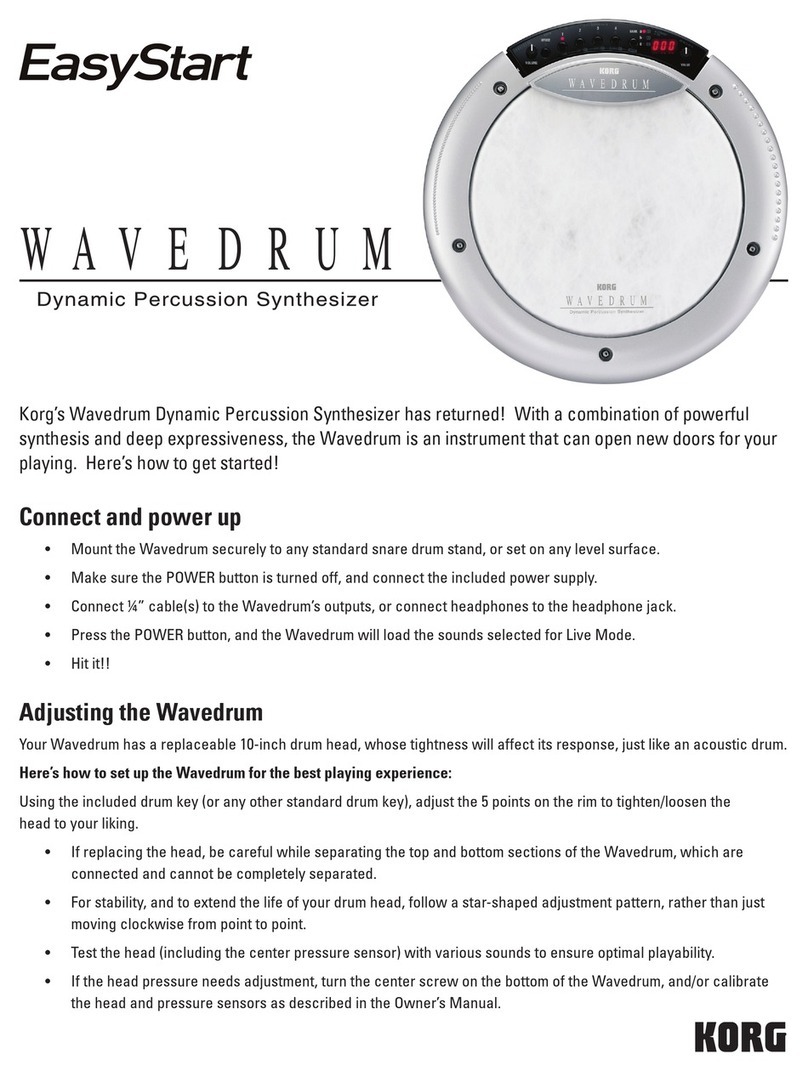
Korg
Korg Wavedrum Product information sheet
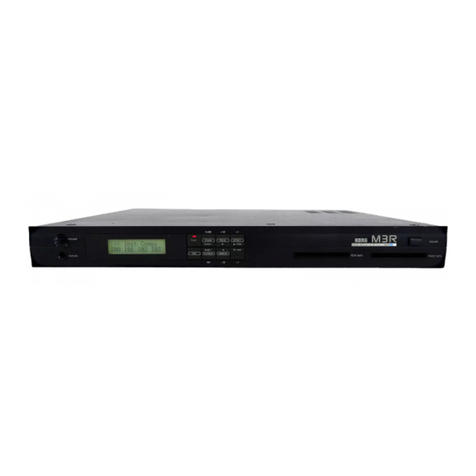
Korg
Korg M3R User manual

Korg
Korg EasyStart X50 Product information sheet
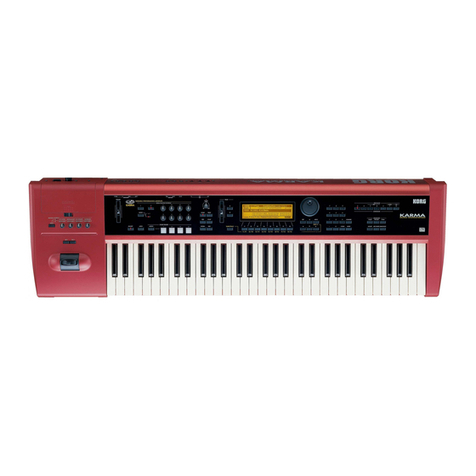
Korg
Korg Karma User manual
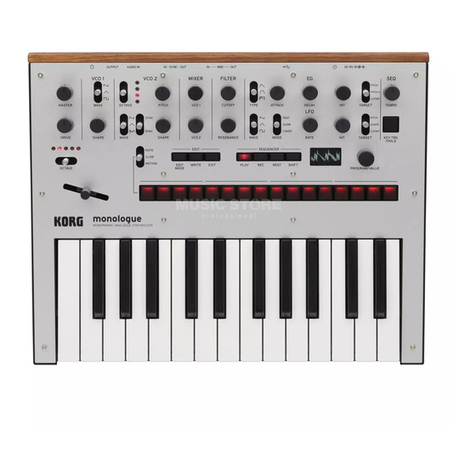
Korg
Korg MONOLOGUE User manual
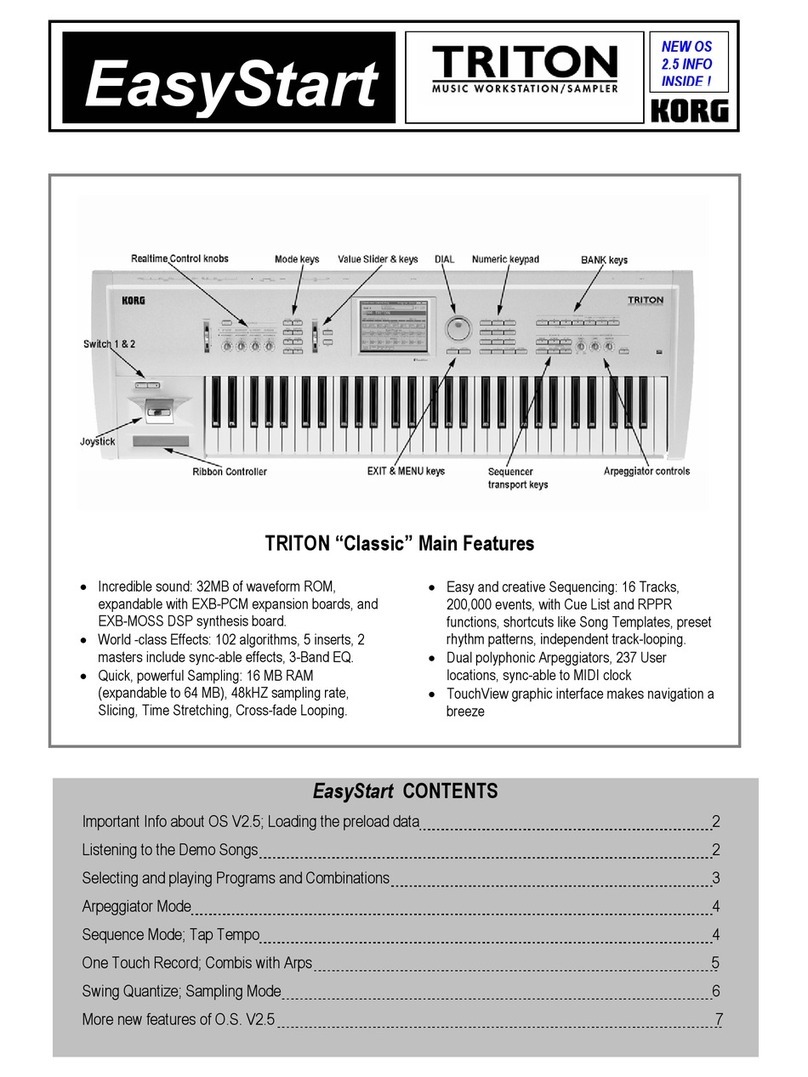
Korg
Korg TRITON Classic Product information sheet

Korg
Korg 800DV User manual
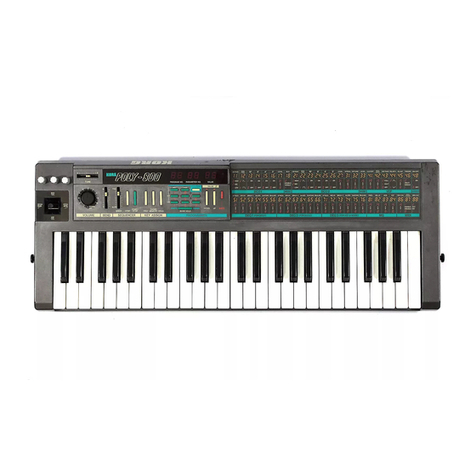
Korg
Korg Poly-800 User manual
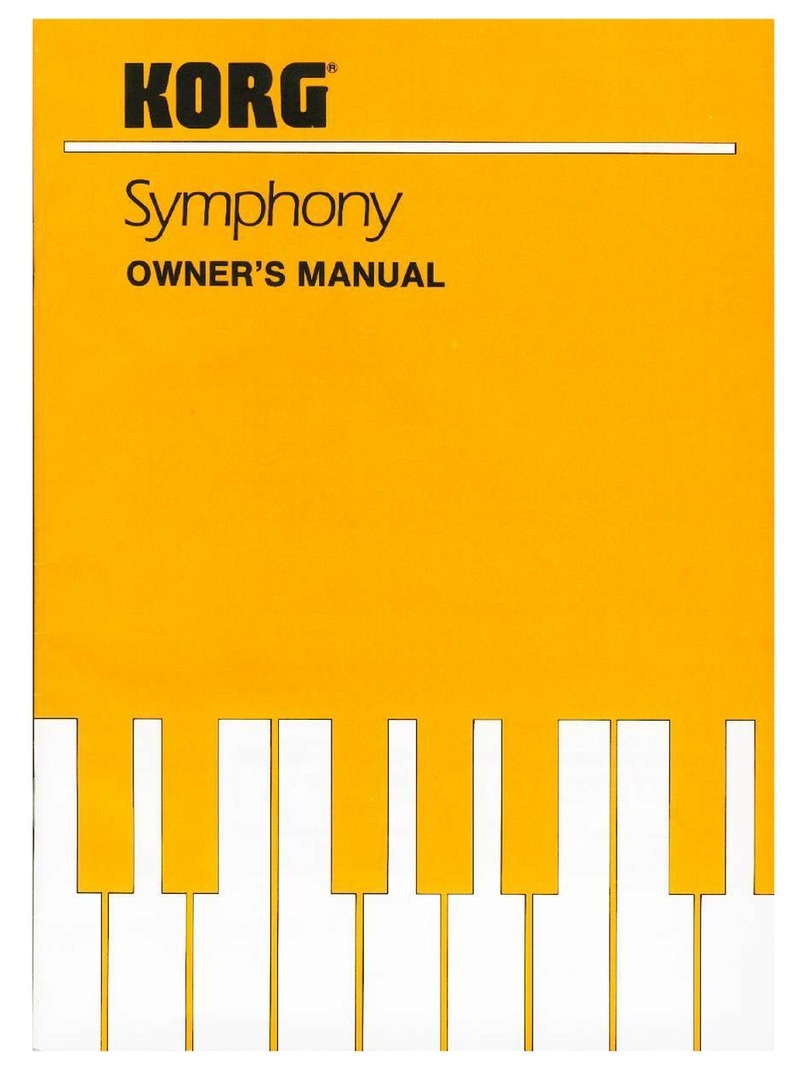
Korg
Korg Symphony User manual
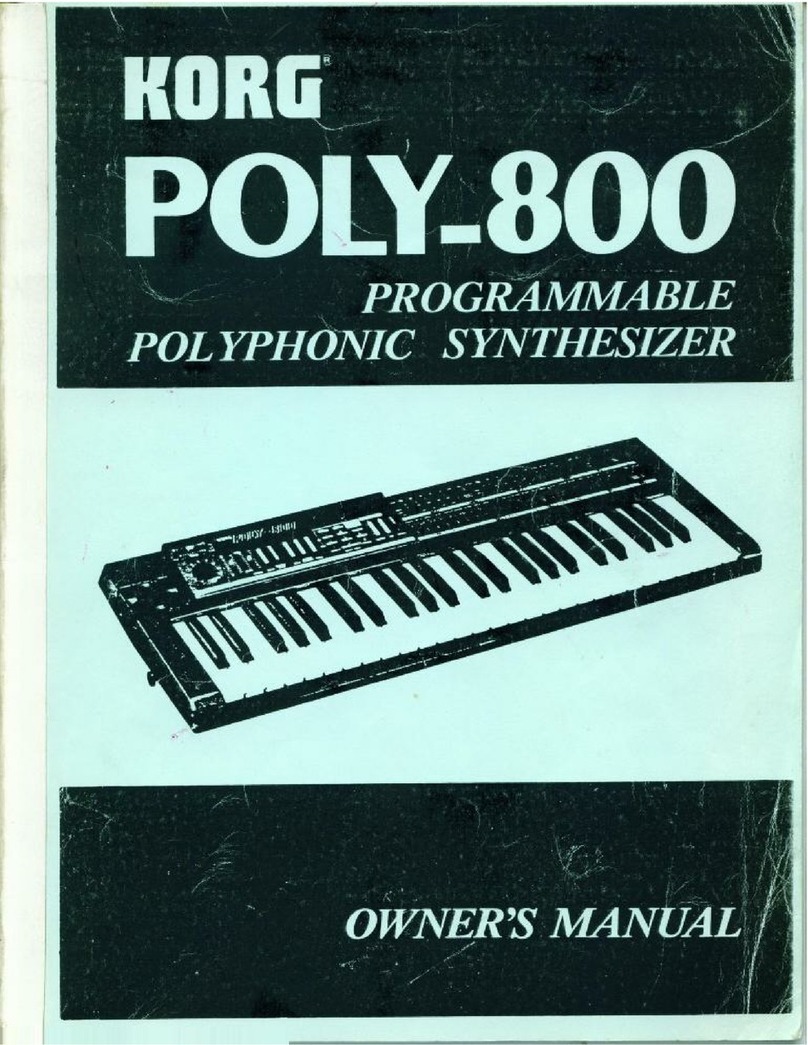
Korg
Korg Poly-800 User manual
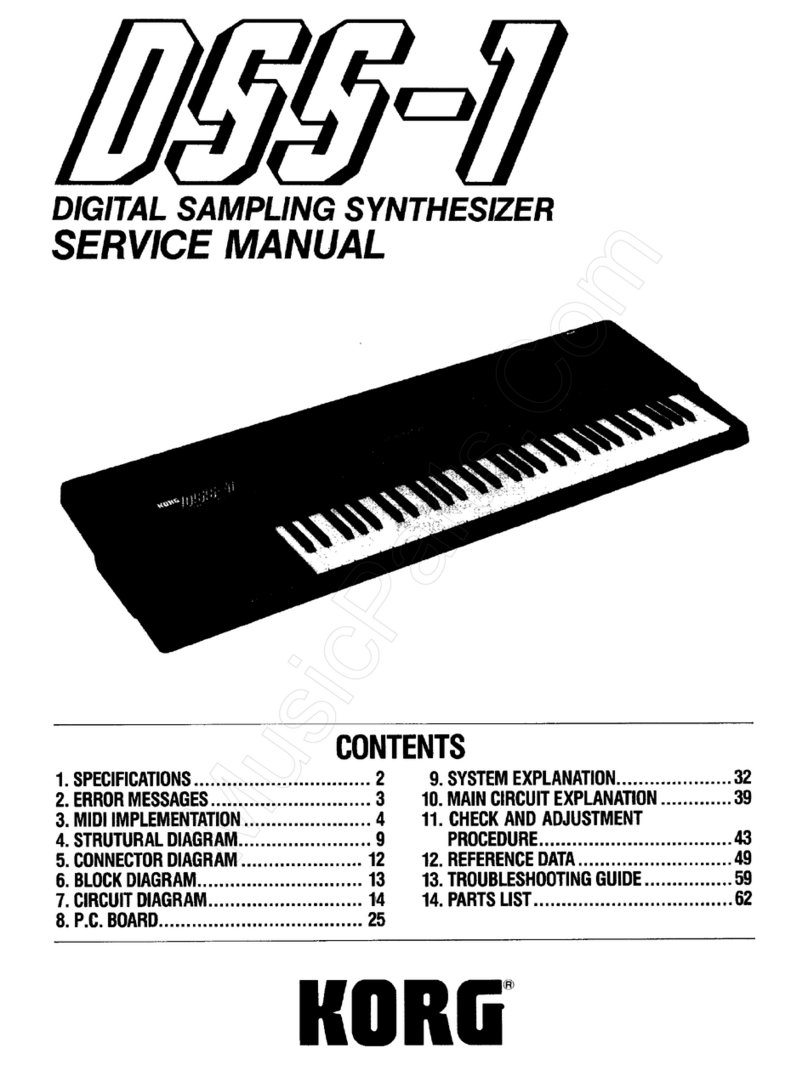
Korg
Korg DSS-1 User manual
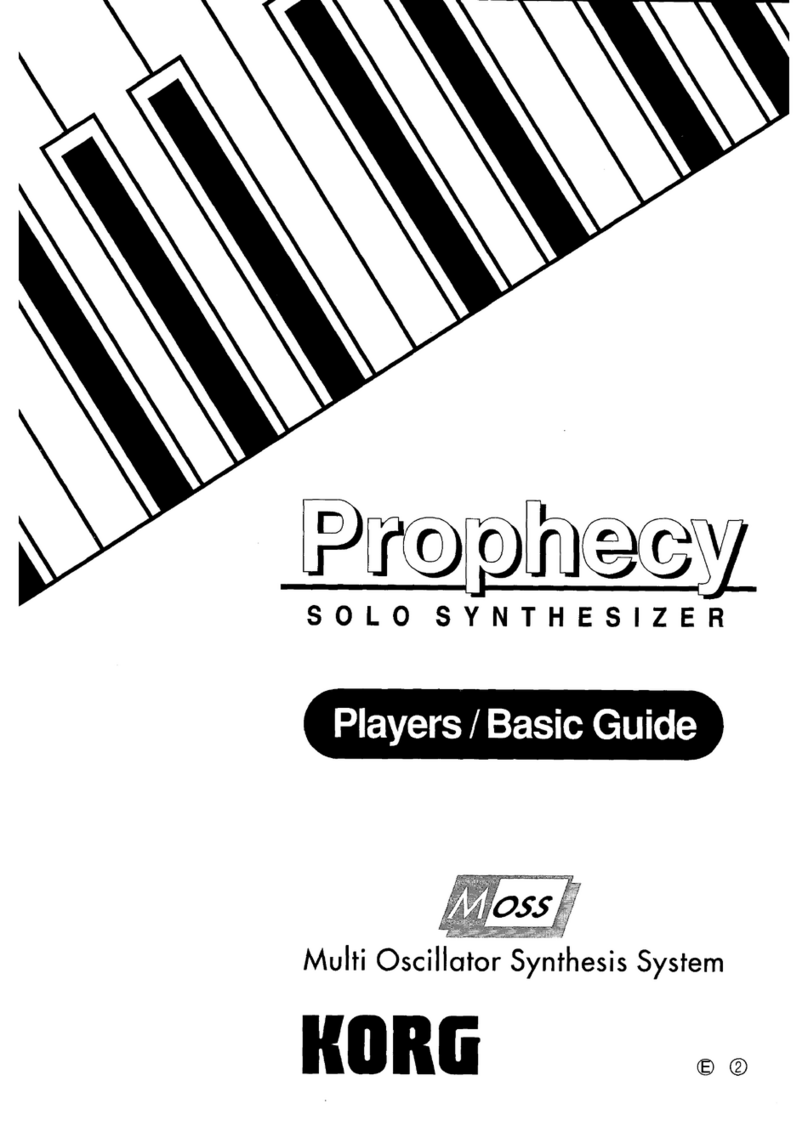
Korg
Korg Prophesy User guide
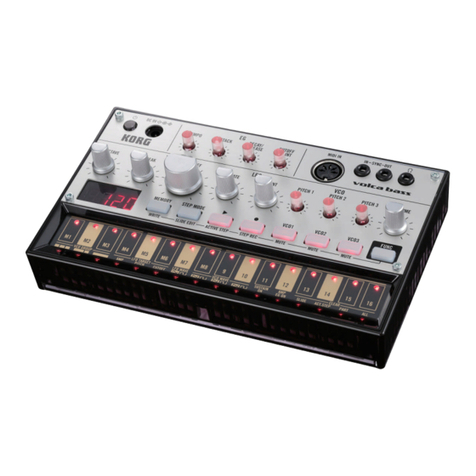
Korg
Korg Volca Bass User manual

Korg
Korg X-911 User manual
